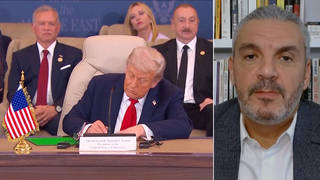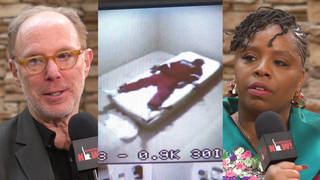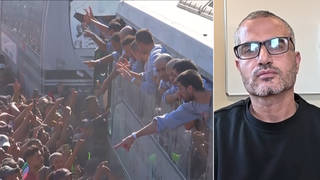
Guests
- Dan Cohensocial worker and the founding executive director of Music & Memory. His work inspired the new documentary, Alive Inside: A Story of Music & Memory.
- Michael Rossato-Bennettthe director and producer of Alive Inside: A Story of Music & Memory, which premiered Saturday at the Sundance Film Festival.
Could a pair of headphones change the lives of millions of Americans suffering from Alzheimer’s and dementia? “Alive Inside: A Story of Music & Memory,” a new documentary at the Sundance Film Festival, follows a social worker named Dan Cohen who has launched a campaign to bring iPods and music therapy to nursing homes. One of the central characters he works with is a 90-something Alzheimer’s patient named Henry Dryer, who was featured in a video posted online that went viral in 2012, with nearly 10 million views. The clip begins with video of Dryer looking largely unresponsive to the outside world. Then he was given a pair of headphones to listen to Cab Calloway, his favorite artist. The music energizes him, awakens him and helps bring back old memories. We play clips from the film and speak with Cohen about his project, “Music & Memory,” which he hopes to expand around the world. We are also joined by Michael Rossato-Bennett, the film’s director and producer.
Transcript
AMY GOODMAN: We turn now to Alive Inside: A Story of Music & Memory. That’s the name of a new documentary that examines how music helps those with Alzheimer’s. You might be familiar with one of the central characters in the film, a 90-something Alzheimer’s patient named Henry Dryer. The documentary makers of Alive Inside posted video of Henry on YouTube in 2012. The clip began with video of him looking largely unresponsive to the outside world. Then he’s given a pair of headphones to listen to Cab Calloway, his favorite. The music energizes him, awakens him, brings back old memories. The clip of Henry went viral, was seen nearly 10 million times. Well, the film Alive Inside is now done and has just premiered here in Park City at the Sundance Film Festival. Here’s an excerpt featuring Henry.
YVONNE RUSSELL: He was very isolated, and he used to always sit on the unit with his head like this. He didn’t really to much people. And then when I introduced the music to him, this is his reaction ever since.
DR. OLIVER SACKS: So, in some sense, Henry has reacquired his identity for a while through the power of music.
INTERVIEWER: What does music do to you?
HENRY DRYER: It gives me the feeling of love, romance, because right now the world needs to come into music, singing. You’ve got beautiful music here. Beautiful, oh, lovely. And I feel a band of love, dream.
AMY GOODMAN: That’s an excerpt from Alive Inside: A Story of Music & Memory. The film follows a social worker named Dan Cohen, who is campaigning to bring iPods to nursing homes. With more than five million Americans living with dementia or memory loss, Dan is hoping to greatly expand his program. Dan Cohen joins us here in Park City, Utah. He is a social worker, founding executive director of Music & Memory. We’re also joined by Michael Rossato-Bennett, director and producer of Alive Inside: The Story of Music & Memory.
Well, we watched this film on the plane from Tokyo, Japan, to Park City, Utah, and was totally astounded. Dan, talk about your discovery, how you ended up in a nursing home and bringing these headphones to the people there.
DAN COHEN: Well, in 2006, I was listening to a journalist talking about how iPods are ubiquitous, they’re everywhere. And I thought, well, young people all have them, many adults, but a nursing home? And if I’m ever in a nursing home, would I have access to my favorite '60s music? So I did an Internet search on iPods and nursing homes. And even though there are 16,000 nursing homes in the U.S., I couldn't find one that was using iPods for their residents. So I called up a local nursing home, and I said, “I know music is already your number one recreational activity, but can we see if there’s any added value if we were to totally personalize music for individuals?” So I came in with my laptop and some iPods, and it was an instant and definitive hit with folks there.
AMY GOODMAN: Well, talk about what happens. Talk about the transformation.
DAN COHEN: Well, when I first started, they didn’t connect me with people with dementia. They didn’t really know me. I was a volunteer coming in. But still, for people who are cognitively sharp as a tack but have physical issues, it really transformed their mood, their emotion. People who were depressed now were feeling better. People who were not very interactive with others became more social. So, it just had different benefits for everybody.
AMY GOODMAN: Set up this clip for us. It’s the clip about Denise.
DAN COHEN: Well, Denise is a bipolar schizophrenic, is very sort of busy with a lot of thoughts and trying to sort of make her way through the day. The music—and very raw with emotions in all different directions, happy and sad and angry. And the music helps to—well, gives her a source of enjoyment and distracts her from that, and it’s just really a real benefit for her.
AMY GOODMAN: So, this clip begins with one of the people who work at the nursing home and then Denise.
NURSE: Denise is probably an extreme resident that we have here.
DENISE: I’m being emphatic, and I have a very vivid imagination. I’m very resilient, and I drop. And I keep on trying, and I drop. But I never stop, and I drop. One of these days I’m going to drop and stay on the floor!
I won’t fall.
DAN COHEN: OK, OK.
DENISE: I’ve lived here two years and never fell.
DAN COHEN: Good.
I couldn’t believe the music let Denise push away her walker. She’d been using that walker every day for two years.
DENISE: It’s Spanish. You’re not Spanish.
DAN COHEN: No, I’m not Spanish. OK, now I’ll follow your lead.
DENISE: I’m having fun.
DAN COHEN: Good! Me, too.
We had seen what music can do for memory, but with Denise, we saw what music can do for the spirit.
AMY GOODMAN: An excerpt from Alive Inside: A Story of Music & Memory. For our radio audience, that clip, yes, began with Denise sitting in her wheelchair. Then she’s given headphones playing salsa music. The clip ends with her standing up and dancing. We’re joined by Dan Cohen, who’s a social worker who thought of bringing in these headphones to the nursing home, and Michael Rossato-Bennett, who filmed all of this. Michael, talk about how you came into this.
MICHAEL ROSSATO-BENNETT: Well, we were—I saw—you know, Dan had a beautiful project, and I had done work for the Shelley & Donald Rubin Foundation, and I was asked to help out a little bit. And when I saw what was happening, I was like, the only way to tell this story is through film, because this is, you know, so amazing.
But I had a—when I was younger, I had like a lot of kind of bad experiences in hospitals. And I went into these nursing homes with Dan, and I saw all these elders just sort of sitting along the walls and with their heads down, and it was a very scary experience for me to be there. And I couldn’t—I really actually couldn’t imagine—can you imagine living in that environment, ending your life in that environment? And it was actually sort of frightening for me to actually enter this place that was their home, you know?
And so, then, one of the first people, if not the first person, that I saw was Henry. You know, we set up our cameras, and this guy came in, and he was just completely gone to the world, right? And then, when he got his headphones and when he came alive—you know, we talk about it in the film, but there is sort of a kinesthetic reaction that happens to you. When you see somebody like come to life, it really just completely does something to you. And, you know, that first day, I cried, literally, five times. And I don’t ever cry, ever. And, you know, you see these people living just really such sad lives.
AMY GOODMAN: And certainly, Dan, this goes beyond people with dementia or Alzheimer’s.
DAN COHEN: Yes, just the way we all love music, and when we get older, we’re going to still love music. And so, just because someone is in a nursing home, and they’re old, and they can no longer operate equipment, and they very often lose access to their favorite music, so we really want to restore that access for everyone, regardless of whether they have dementia or not.
AMY GOODMAN: And talk about how it taps into something. It not only—they’re not only just, you know, rocking out to the beat. It’s bringing back memories. They’re sometimes talking, and they haven’t talked in months.
DAN COHEN: Yeah, so, with advanced dementia, when people no longer can recognize their own family members, they stop speaking. But when they hear music that’s familiar from their youth, because those memories are preserved, they come alive. They connect with that. It’s a direct sort of a backdoor to that failing cognitive system right to the emotional system, which is really very much intact. And what we love—what music does, the way we connect with music is really very much emotional and visceral.
AMY GOODMAN: Let’s go to another clip from Alive Inside: A Story of Music & Memory. This is recreation therapist Yvonne Russell.
YVONNE RUSSELL: I have one resident that barely opened her eyes. She didn’t respond. As much as I tried in over two years, no matter what I tried, massage wouldn’t work. Nothing worked. But when we got introduced to the iPods and the family told me the things that she liked, it was amazing once we put the iPod on her. She started shaking her feet. She started moving her head. Her son was just amazed. OK, can we stop? Because now I’m getting all—I’m seeing her all over again.
AMY GOODMAN: That was Yvonne Russell, the recreation therapist in the nursing home, describing her patient. I mean, Dan, for the people listening on radio who can’t see, and just overall, talk about what happened to this woman who was laying in the bed.
DAN COHEN: This woman is laying, and she’s kind of in a fetal position and eyes closed, and she’s really, you know, end of life, and there’s no—there’s no sitting up. She’s bedridden. And the music comes on, and she appears comatose at first, but she then starts shaking, writhing to the music. Her head’s moving. Her body is moving. Even though her eyes are closed and she’s lying down in this fetal position, it’s just really moving to watch.
AMY GOODMAN: You know, years ago, my grandmother, well, lived 'til 108. And she wasn't senile. She did not suffer from dementia. But in those last years, she was very hard of hearing. And I was talking to her, and I was racing off for a radio interview, and I said, “I have to go.” She said, “What, darling?” I said, “I have to leave.” She said, “What, darling?” And I’m so frustrated, so I said—and I realize I’m holding my tape recorder and the headphones. And I just put them on her head, and I said, “I have to go, Grandma.” She said, “So then what’s keeping you?” And that just changed everything. I spoke into the mic, and I put the headphones on her. So then, when we had lunch with my brothers and my mom, I would put the headphones on her, and I’d say, “Let’s pass the mic when we’re talking,” just even to each other, not even to her. And then she is a part of the conversation, because so often older people—I mean, people are polite. They don’t want to keep saying, “What?” Michael, let me ask you about that, that experience of not just music, but hearing people’s voices in full throttle.
MICHAEL ROSSATO-BENNETT: Right. That’s one of the things that touched me so much about this whole experience, is that for people with dementia, they’re really struggling with the outside world, and the stimulus is so overwhelming, and they don’t have the ability to sort of discern what’s happening. And when you put headphones on a person like that, there’s a double gift. Not only is the music incredible, but what you’re doing is you’re limiting the world to something that is totally pleasurable and is simple and is a lot of—the beat is like—it keeps going. There’s a lot of faith involved in it. And so the world becomes a much more beautiful place, like the entire—the entire, like, craziness of maybe the institution that they’re living in disappears.
And one thing that was so profound for me was the depth of emotion that they were capable of. Do you know—like, you see these people, and you can’t help but say, you know, they’re not as alive as the rest of us. But then when you see them—the world kind of going into a place where they’re comfortable and where they’re deeply profound, that was what really blew me away, was that these people that sort of it seemed like everyone thinks are gone are literally capable of profound experience at the level that we are, you know, and that was a shocker for me. And—
AMY GOODMAN: Every part of this film—I mean, you deal, overall, Dan, with the issue of what you call “elderhood.” What are we doing with the older people in our society who could contribute so much? In nursing homes—we’re not talking about rat-infested, cockroach-crawling nursing homes—the very opposite. We’re talking about clean, antiseptic, four white walls, people who already their lives sort of stripped away from them, their identities they have known. That’s what they’re left with in the last years of their life, and yet there’s so much that could be, so much that could be.
DAN COHEN: So, the nursing homes—because our society reduces every year the amount of money going to nursing home care, the nursing homes, filled with great staff, dedicated people, have to do the same—give the same level of service every year to this group of people. And so, as a result, they have to have activities for the group as opposed to the individual. But when we’re in a nursing home, there are all sorts of individual activities and hobbies we’d like to do, but it’s just—it’s very hard for them to carry that out. So, as a society, we need to really support these long-term care facilities more.
AMY GOODMAN: What are the numbers we’re talking about? One million people in nursing home—
DAN COHEN: So, 1.6 million, approximately, living in 16,000 nursing homes, plus another million people living in assisted living facilities. Forty percent of those folks in assisted living have some form of dementia, as well. And then you have seven million people being cared for at home. And, of course, five million of all—five million people in the U.S. have dementia.
AMY GOODMAN: You say in the film doctors can write out a prescription for a thousand dollars for antidepressants, but it’s hard to get $40 for a CD player.
DAN COHEN: Yes. It just doesn’t—it’s not reimbursable. It’s not an acceptable expense. So, the drugs—
AMY GOODMAN: And the drug companies don’t make money.
DAN COHEN: And—well, right now, our system is set up that if it’s a drug, regardless of what it is, regardless of the side effects, because we are really giving these folks antipsychotic medications to help calm them down, but they’re really not meant for this, and the side effects are so dramatic that the government is telling them, “Please, all doctors, slow down on your use of these.” And doctors in nursing homes, and also someone at home whose mom might have been behaving out of control, and the daughter says, “Doc, give my mom something, please.” So, it’s just our approach to, like, we need medications to help.
AMY GOODMAN: And you talk about how in other cultures elders are brought into society, to work—I mean, being there with children, who are left alone also. But people are so isolated. We have no place now in our society.
DAN COHEN: Well, that’s very true. And so now we have these institutions where we’d love to get the community in more. So, I like to say that, gee, my local school, I can hardly find a parking space, but it’s never a problem in a nursing home. But as people with dementia become—when I started this, people said, “Dan, you’re going to isolate people even more by putting headphones on them.” And it turned out just the opposite happened: People became more social. “Oh, you’ve got to hear this. Oh, this reminds me of when I met my husband,” or, “You’re about my age. Remember the Andrews Sisters?”
AMY GOODMAN: And you have kids bringing in—
DAN COHEN: So, let’s—
AMY GOODMAN: —iPods to older people—
DAN COHEN: Yes.
AMY GOODMAN: —and then they’re hanging out with the older people together.
DAN COHEN: It’s the perfect storm for intergenerational activity.
AMY GOODMAN: I want to thank you both for being with us. The film is amazing. Dan Cohen, social worker, founding executive director of Music & Memory, his work inspired the new documentary, Alive Inside: A Story of Music & Memory. Michael Rossato-Bennett is the director and producer of the film.
That does it for the show. I’ll be speaking this Friday, January 24th, at 1:00 p.m. at Dolly’s, the independent bookstore on Main Street here in Park City.












Media Options